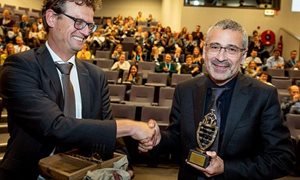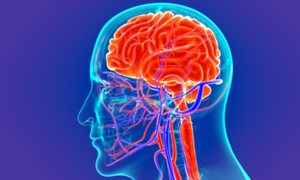5 November 2019
The most commonly used method in breast cancer detection is mammography. However, mammography is less suitable in women with relatively more glandular tissue (dense breast). Around 44% of the women have dense breast. As alternative, 3-D ultrasound imaging can be used to detect breast cancer. The sonographer collects ultrasound images while the ultrasound probe moves over the breast. Afterwards, the radiologist can evaluate the ultrasound images. Gijs Hendriks developed a technique called 3-D elastography which can ‘feel’ stiff structures in soft surrounding breast tissue using the already collected 3-D ultrasound images. Malignant cancers are often stiffer and less mobile compared to benign lesions which are softer and mobile. The radiologist can better discriminate between benign and malignant lesions by measuring stiffness and mobility of lesions. In this way, unnecessary biopsies can be prevented. In his research he developed and validated this technique in computational models, breast phantoms and patient studies.
Gijs Hendriks and Chris de Korte are members of theme Vascular damage.

The most commonly used method in breast cancer detection is mammography. However, mammography is less suitable in women with relatively more glandular tissue (dense breast). Around 44% of the women have dense breast. As alternative, 3-D ultrasound imaging can be used to detect breast cancer. The sonographer collects ultrasound images while the ultrasound probe moves over the breast. Afterwards, the radiologist can evaluate the ultrasound images. Gijs Hendriks developed a technique called 3-D elastography which can ‘feel’ stiff structures in soft surrounding breast tissue using the already collected 3-D ultrasound images. Malignant cancers are often stiffer and less mobile compared to benign lesions which are softer and mobile. The radiologist can better discriminate between benign and malignant lesions by measuring stiffness and mobility of lesions. In this way, unnecessary biopsies can be prevented. In his research he developed and validated this technique in computational models, breast phantoms and patient studies.
Gijs Hendriks and Chris de Korte are members of theme Vascular damage.
Related news items

Grants for heart and kidney research Two awards to Radboudumc in Open Competition ENW-XS
21 July 2022Two researchers from the Radboudumc receive a grant from the NWO within the Open Competition of the Exact and Natural Sciences. They are Thijs Eijsvogels, who studies the heart, and Pieter Leermakers, who studies the kidneys.
go to page
Your heart rate as a thermometer Research Olympic athletes will be followed up during 4Daagse
18 July 2022Body temperature can be determined from heart rate. This is what research by the Radboudumc among Olympic athletes shows. Athletes can use this method during training to eventually perform better in the heat. The technique is now being further investigated among participants in the 4Daagse.
go to page
Report of the 12th New Frontiers symposium Big data, better healthcare? - 1 November 2018
7 November 2018 Examples from the application of deep learning to image reading in pathology and radiology and the application of network medicine to monitor infectious disease outbreaks or collective mood states using twitter data showed the huge potential of big data approaches for building better healthcare. go to page


